The First Signs of Spring: Spotting Invasive Plants
As the weather warms and our days stretch longer and brighter, we begin to see and hear the bustle of the natural world picking up all around us. The spring peepers are calling, migratory birds are returning to their summer homes, and splashes of green are beginning to pop up against the otherwise dull backdrop of our post-winter forests and yards.
Did you know that many non-native, invasive plants are the first to leaf out each spring? This is one strategy that allows them to outcompete our native plants. It can also make these plants easier to find to target them for removal, but don’t tell them that!
What are invasive plants?
An invasive plant is not native to a given region and is likely to cause significant economic or ecological harm. Some invasive plants also pose risks to human health. In some cases, invasive plants can reduce biodiversity, degrade wildlife habitat and water quality, and inhibit forest regeneration. They grow quickly, are often the first to leaf out in the spring and the last to lose their leaves in the fall. These plants aggressively out compete native plants by exploiting water, nutrients, light and space. And because they are not native to our local ecosystem, they have no natural enemies (insects and diseases) to keep them in check.
Who is leafing out?
Some of these ambitious plants started leafing out in New Hampshire in early April. So far Japanese and European barberry, honeysuckle, and multiflora rose have been observed leafing out. All of these shrubs were introduced to the US as landscape plants. Japanese barberry was introduced to replace European barberry after it was discovered to be a host for black stem grain rust. Multiflora rose was widely planted in the first half of the 20th century for wildlife habitat and erosion control.
Japanese and European Barberry
Japanese and European barberry are dense, thorny shrubs. European barberry tends to have a more upright habitat and the thorns are three-pronged, on Japanese barberry the thorns are singular. They have small oval shaped leaves that are just beginning to emerge. European barberry leaves are finely toothed along the edges, this is less obvious when the leaves first emerge. You might also observe some of last year’s fruit. These are small drupes that turn red in summer. Their seeds have a high germination rate and are dispersed by wildlife like ruffed grouse and wild turkeys. These plants can also spread by rhizomes and layering. They are shade tolerant making it easy for them to become established under closed canopy forest and deer tend to avoid barberry and browse our native plants instead. In addition to the sharp spines it is associated with a higher abundance of black legged ticks which are a vector for Lyme disease. This plant is often seen growing on moist soils under the shade of the forest canopy.
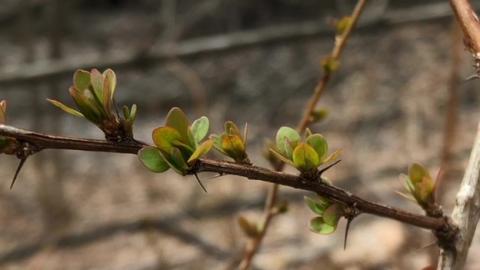
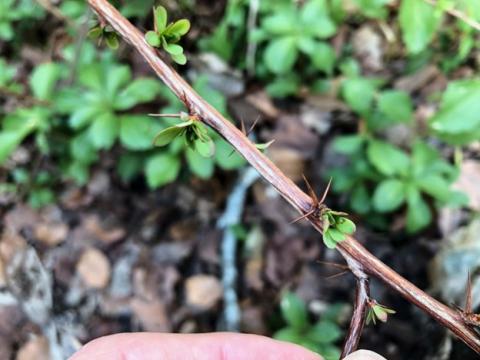
Multiflora rose
Multiflora rose is a hardy climbing shrub with long and arching stems or canes that forms dense impenetrable thickets displacing native plants. If you have ever walked through an old field, you have probably had an unpleasant encounter with this plant. It commonly has sharp recurved thorns. The leaves are alternate and pinnately compound, meaning each leaf is divided into smaller leaflets arranged along the main leaf stalk or rachis, each leaf has 7-9 leaflets. The fringed stipules at the base of each leaf help distinguish this plant from native roses. The flowers are white and pink in clusters and bloom from June to July and produce the small red fruits called rose hips. The fruit is dispersed by birds and this plant will also root in from the long arching stems where they touch the ground. It prefers sunny sites with well drained soils and aggressively colonizes old fields, open woodlands and forest edges. While it provides dense cover for wildlife it will aggressively outcompete native plants.
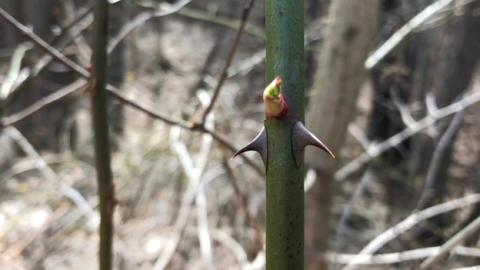
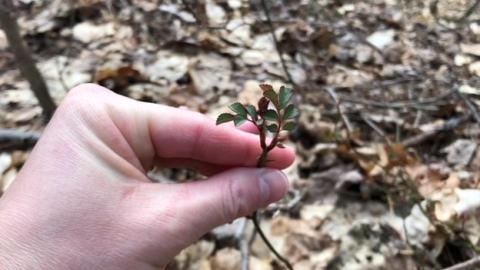
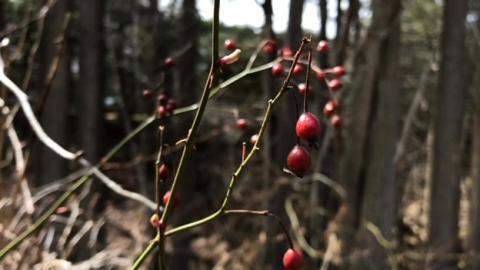
Burning Bush
Burning bush is well known for its attractive bright red fall color. Even if this plant has yet to leaf out, it has some distinctive characteristics that make it easy to identify. It has a dense branching pattern, and the younger stems are green with corky wings. The leaves are oppositely arranged on the branches and, elliptic in shape. The fruit are fleshy green capsules that turn red in fall and are dispersed by birds and other wildlife. Because it can tolerate a wide range of light and soil conditions it outcompetes and displaces native species. Deer also tend to avoid browsing it favoring native plants.
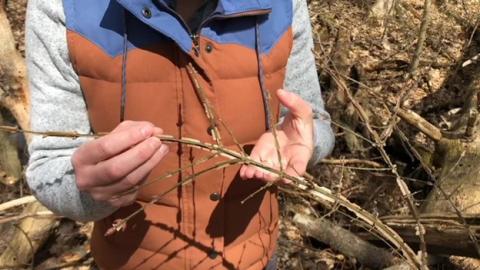
If you find these plants on your property they can be controlled in a variety of manners. Small immature plants can be pulled by hand, be sure to wear gloves when removing thorny plants like barberry and multiflora rose. Larger plants can be dug out or removed using a weed wrench or other mechanical means. Herbicide treatments are also an option for larger populations.
What’s leafing out in your backyard?
Unfortunately, the four plants discussed above are not the only invasive plants commonly found in New Hampshire. Doug Cygan, at the NH Department of Agriculture, created this handy Guide to Upland Invasive Plants, which is a great resource to help you monitor your property. In addition, for more information on invasive plants, control options, and native plant alternatives please check out these resources:
- https://extension.unh.edu/resource/invasive-plants
- https://www.agriculture.nh.gov/divisions/plant-industry/invasive-plants.htm
Related Resource(s)

